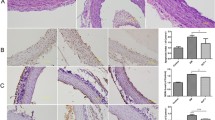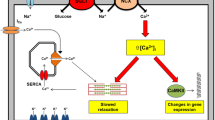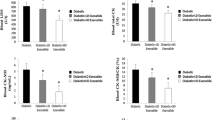Abstract
Glucagon-like peptide-1 (GLP-1), a gut incretin hormone secreted from L cells, and a GLP-1 receptor agonist, exendin-4 (Ex-4) has been shown to be cardioprotective and could exert beneficial effects through its anti-inflammatory property. However, the mechanism remains unclear. The purpose of this study was to investigate whether Ex-4 could ameliorate myocardial cell injury by inhibiting high mobility group box 1 (HMGB1) expression under high glucose condition. Neonatal rat ventricular myocytes were prepared and then cultured with high glucose and different concentration of Ex-4. Lactate dehydrogenase (LDH), creatine kinase (CK), tumor necrosis factor-α (TNF-α) and interleukin-1β (IL-1β), malondialdehyde (MDA) and superoxide dismutase (SOD) were measured. HMGB1 expression was assessed by western blotting. Ex-4 significantly inhibited the increase in LDH, CK, TNF-α, IL-1β and MDA levels induced by high glucose, especially at the 1 and 10 nM concentrations as well as suppressed the decrease in SOD level. Meanwhile, HMGB1 expression was markedly increased after 12 h of hyperglycaemia (P < 0.05), which was significantly inhibited by Ex-4, especially at the 1 and 10 nM concentrations (P < 0.05). The present study suggested that Ex-4 could reduce high glucose-induced cardiocytes injury, which may be associated with the inhibition of HMGB1 expression.




Similar content being viewed by others
References
Reasner CA (2008) Reducing cardiovascular complications of type 2 diabetes by targeting multiple risk factors. J Cardiovasc Pharmacol 52:136–144
Bell CW, Jiang W, Reich CF 3rd, Pisetsky DS (2006) The extracellular release of HMGB1 during apoptotic cell death. Am J Physiol Cell Physiol 291:C1318–C1325
Scaffidi P, Misteli T, Bianchi ME (2002) Release of chromatin protein HMGB1 by necrotic cells triggers inflammation. Nature 418:191–195
Hu X, Jiang H, Bai Q, Zhou X, Xu C, Lu Z, Cui B, Wen H (2009) Increased serum HMGB1 is related to the severity of coronary artery stenosis. Clin Chim Acta 406:139–142
Hu X, Zhou X, He B, Xu C, Wu L, Cui B, Wen H, Lu Z, Jiang H (2010) Minocycline protects against myocardial ischemia and reperfusion injury by inhibiting high mobility group box 1 protein in rats. Eur J Pharmacol 638:84–89
Hu X, Zhou W, Bai Q, Wang J, Yang X, Xu C, Lu Z, Xia H, Jiang H (2011) Increased serum high mobility group box 1 protein in patients with atrial fibrillation. Biomed Aging Pathol 1:52–55
Volz HC, Seidel C, Laohachewin D, Kaya Z, Müller OJ, Pleger ST, Lasitschka F, Bianchi ME, Remppis A, Bierhaus A, Katus HA, Andrassy M (2010) HMGB1: the missing link between diabetes mellitus and heart failure. Basic Res Cardiol 105:805–820
Kieffer TJ, Habener JF (1999) The glucagon-like peptides. Endocr Rev 20:876–913
Wettergren A, Schjoldager B, Mortensen PE, Myhre J, Christiansen J, Holst JJ (1993) Truncated GLP-1 (proglucagon 78-107-amide) inhibits gastric and pancreatic functions in man. Dig Dis Sci 38:665–673
Yamamoto H, Lee CE, Marcus JN, Williams TD, Michael Overton J, Lopez ME, Hollenberg AN, Baggio L, Saper CB, Drucker DJ, Elmquist JK (2002) Glucagon-like peptide-1 receptor stimulation increases blood pressure and heart rate and activates autonomic regulatory neurons. J Clin Invest 110:43–52
Sonne DP, Engstrøm T, Treiman M (2008) Protective effects of GLP-1 analogues exendin-4 and GLP-1(9-36) amide against ischemia-reperfusion injury in rat heart. Regul Pept 146:243–249
Ban K, Noyan-Ashraf MH, Hoefer J, Bolz SS, Drucker DJ, Husain M (2008) Cardioprotective and vasodilatory actions of glucagon-like peptide 1 receptor are mediated through both glucagon-like peptide 1 receptor-dependent and -independent pathways. Circulation 117:2240–2250
Okerson T, Chilton RJ (2012) The cardiovascular effects of GLP-1 receptor agonists. Cardiovasc Ther 30:e146–e155
Sokos GG, Nikolaidis LA, Mankad S, Elahi D, Shannon RP (2006) Glucagon-like peptide-1 infusion improves left ventricular ejection fraction and functional status in patients with chronic heart failure. J Card Fail 12:694–699
Liu H, Hu Y, Simpson RW, Dear AE (2008) Glucagon-like peptide-1 attenuates tumour necrosis factor-alpha-mediated induction 7 of plasminogen activator inhibitor-1 expression. J Endocrinol 196:57–65
Kodera R, Shikata K, Kataoka HU, Takatsuka T, Miyamoto S, Sasaki M, Kajitani N, Nishishita S, Sarai K, Hirota D, Sato C, Ogawa D, Makino H (2011) Glucagon-like peptide-1 receptor agonist ameliorates renal injury through its anti-inflammatory action without lowering blood glucose level in a rat model of type 1 diabetes. Diabetologia 54:966–978
Arakawa M, Mita T, Azuma K, Ebato C, Goto H, Nomiyama T, Fujitani Y, Hirose T, Kawamori R, Watada H (2010) Inhibition of monocyte adhesion to endothelial cells and attenuation of atherosclerotic lesion by a glucagon-like peptide-1 receptor agonist, exendin-4. Diabetes 59:1030–1037
Hu X, Cui B, Zhou X, Xu C, Lu Z, Jiang H (2012) Ethyl pyruvate reduces myocardial ischemia and reperfusion injury by inhibiting high mobility group box 1 protein in rats. Mol Biol Rep 19:227–231
Festa A, D’Agostino R Jr, Howard G, Mykkänen L, Tracy RP, Haffner SM (2000) Chronic subclinical inflammation as part of the insulin resistance syndrome: the insulin resistance atherosclerosis study (IRAS). Circulation 102:42–47
Hofmann U, Heuer S, Meder K, Meder K, Boehler J, Lange V, Quaschning T, Erti G, Bonz A (2007) The proinflammatory cytokines TNF-alpha and IL-1 beta impair economy of contraction in human myocardium. Cytokine 39:157–162
Westermann D, Van Linthout S, Dhayat S, Escher F, Bücker-Gartner C, Spillmann F, Noutsias M, Riad A, Schultheiss HP, Tschöpe C (2007) Cardioprotective and anti-inflammatory effects of interleukin converting enzyme inhibition in experimental diabetic cardiomyopathy. Diabetes 56:1834–1841
Wang SX, Xie Y, Zhou X, Sha WW, Wang WW, Han LP, Wang JC, Yu DM (2010) Effect of glucagon-like peptide-1 on hypoxia-reoxygenation induced injury in neonatal rat cardiomyocytes. Zhonghua Xin Xue Guan Bing Za Zhi 38:72–75
Ravassa S, Zudaire A, Carr RD, Diez J (2011) Antiapoptotic effects of GLP-1 in murine HL-1 cardiomyocytes. Am J Physiol Heart Circ Physiol 300:H136–H172
Andersson U, Wang H, Palmblad K, Aveberger AC, Bloom O, Erlandsson-Harris H, Janson A, Kokkola R, Zhang M, Yang H, Tracey KJ (2000) High mobility group 1 protein (HMG-1) stimulates proinflammatory cytokine synthesis in human monocytes. J Exp Med 192:565–570
Harris HE, Andersson U (2004) The nuclear protein HMGB1 as a proinflammatory mediator. Eur J Immunol 34:1503–1512
Inoue K, Kawahara K, Biswas KK, Ando K, Mitsudo K, Nobuyoshi M, Maruyama I (2007) HMGB1 expression by activated vascular smooth muscle cells in advanced human atherosclerosis plaques. Cardiovasc Pathol 16:136–143
Kawahara K, Biswas KK, Unoshima M, Ito T, Kikuchi K, Morimoto Y, Iwata M, Tancharoen S, Oyama Y, Takenouchi K, Nawa Y, Arimura N, Jie MX, Shrestha B, Miura N, Shimizu T, Mera K, Arimura S, Taniguchi N, Iwasaka H, Takao S, Hashiguchi T, Maruyama I (2008) C-reactive protein induces high-mobility group box-1 protein release through activation of p38MAPK in macrophage RAW264.7 cells. Cardiovasc Pathol 17:129–138
Lotze MT, Tracey KJ (2005) High-mobility group box 1 protein (HMGB): nuclear weapon in the immune arsenal. Nat Rev Immunol 5:331–342
Fang ZY, Prins JB, Marwick TH (2004) Diabetic cardiomyopathy: evidence, mechanisms, and therapeutic implications. Endocr Rev 25:543–567
Li X, Xu Z, Li S, Rozanski GJ (2005) Redox regulation of Ito remodeling in diabetic rat heart. Am J Physiol Heart Circ Physiol 288:H1417–H1424
Dalla VM, Mussap M, Gallina P et al (2005) Acute-phase markers of inflammation and glomerular structure in patients with type 2 diabetes. J Am Soc Nephrol 16(Suppl 1):S78–S82
Yoshida LS, Tsunawaki S (2008) Expression of NADPH oxidases and enhanced H(2)O(2)-generating activity in human coronary artery endothelial cells upon induction with tumor necrosis factor-alpha. Int Immunopharmacol 8:1377–1385
Zhou Z, Wang L, Song Z, Lambert JC, McClain CJ, Kang YJ (2003) A critical involvement of oxidative stress in acute alcohol-induced hepatic TNF-alpha production. Am J Pathol 163:1137–1146
Tang D, Shi Y, Kang R, Li T, Xiao W, Wang H, Xiao X (2007) Hydrogen peroxide stimulates macrophages and monocytes to actively release HMGB1. J Leukoc Biol 81:741–747
Tsung A, Klune JR, Zhang X, Jeyabalan G, Cao Z, Peng X, Stolz DB, Geller DA, Rosengart MR, Billiar TR (2007) HMGB1 release induced by liver ischemia involves Toll-like receptor 4-dependent reactive oxygen species production and calcium-mediated signaling. J Exp Med 204:2913–2923
Acknowledgments
This study was partially supported by a Grant from National Natural Science foundation of China (No. 81100146), Grant 111023 from the Fundamental Research Funds for the Central Universities and the Specialized Research Fund for the Doctoral Program of Higher Education of China (No. 20110141120060).
Author information
Authors and Affiliations
Corresponding author
Rights and permissions
About this article
Cite this article
Cai, Y., Hu, X., Yi, B. et al. Glucagon-like peptide-1 receptor agonist protects against hyperglycemia-induced cardiocytes injury by inhibiting high mobility group box 1 expression. Mol Biol Rep 39, 10705–10711 (2012). https://doi.org/10.1007/s11033-012-1961-9
Received:
Accepted:
Published:
Issue Date:
DOI: https://doi.org/10.1007/s11033-012-1961-9




